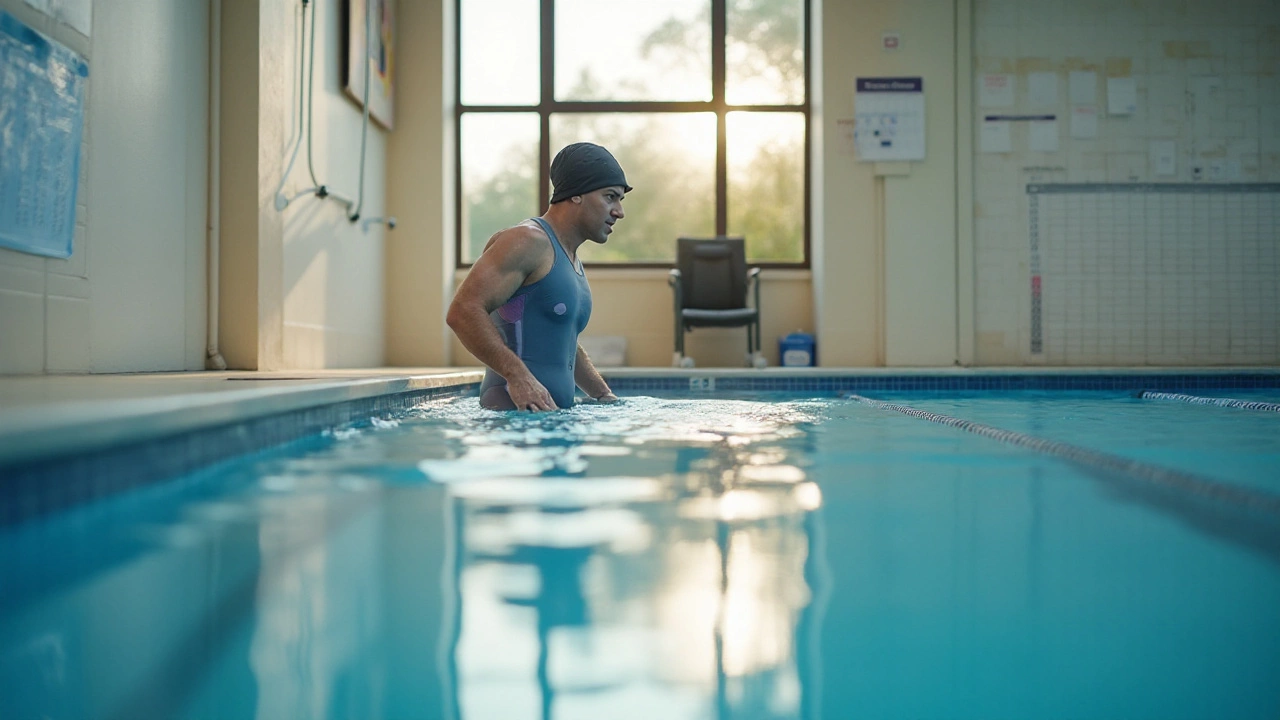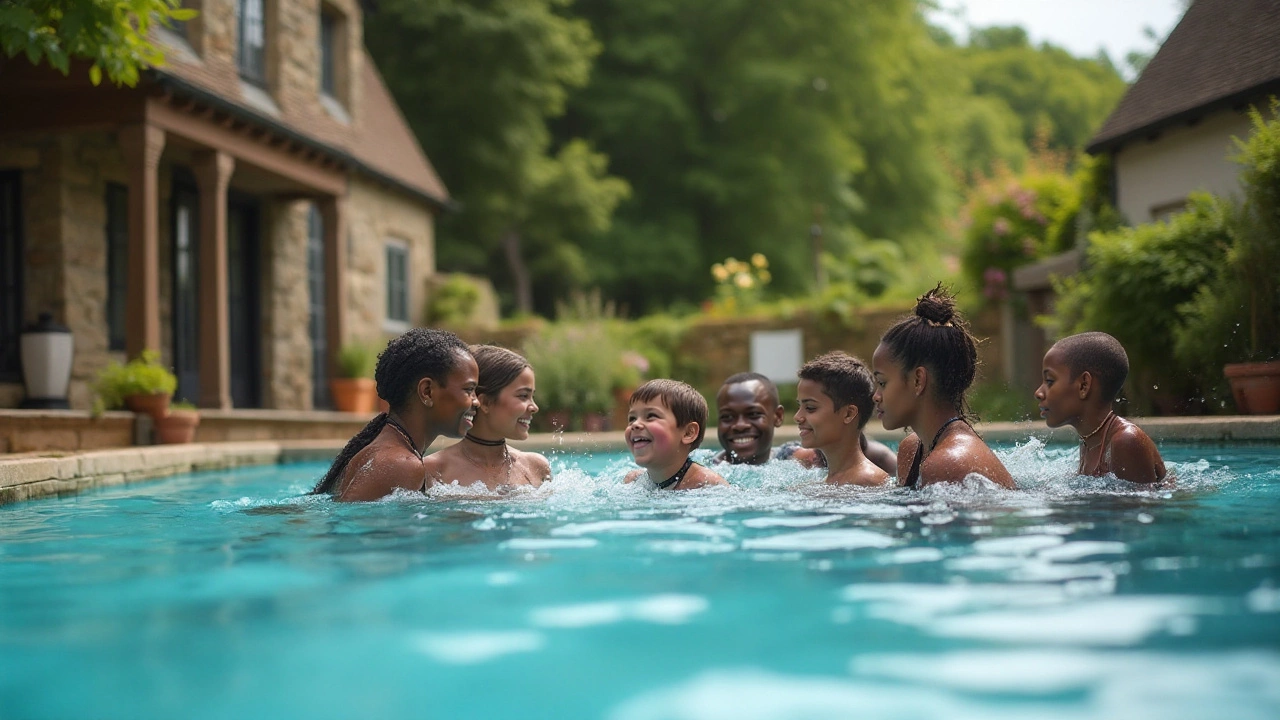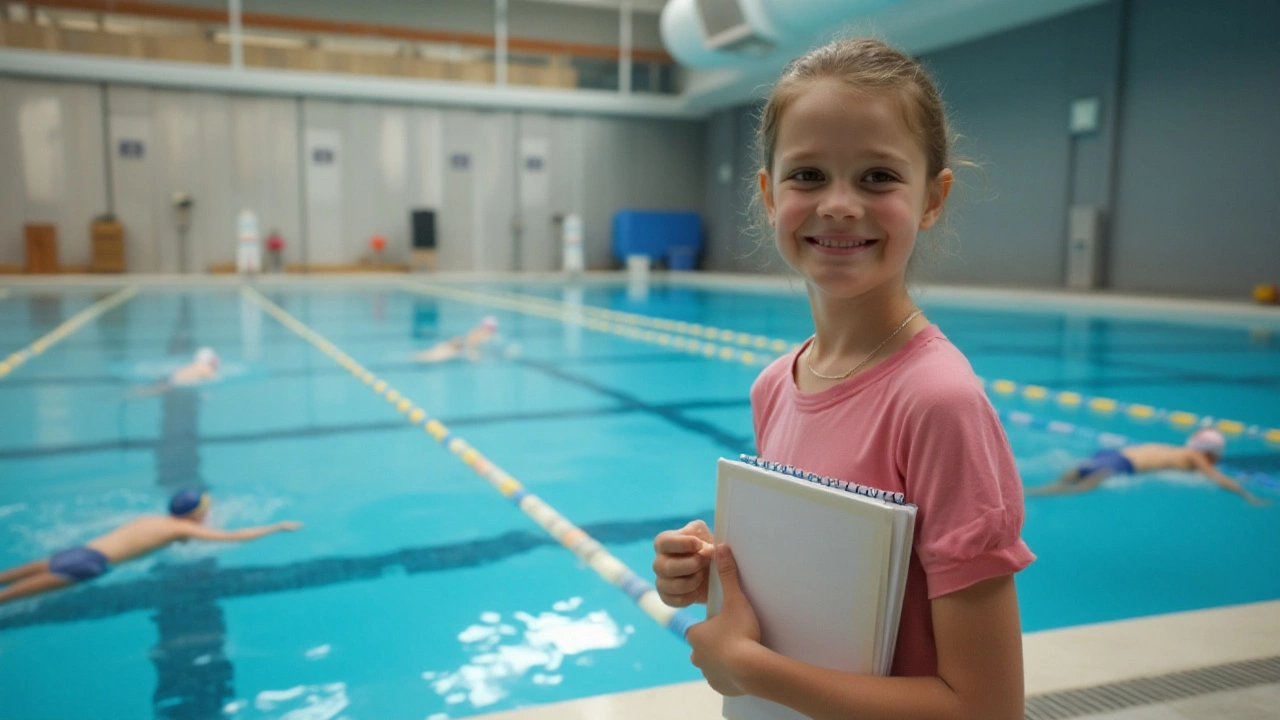
Swimming January 29, 2025
Optimal Swimming Schedule for Beginners: A Guide to Starting Your Journey
Diving into the world of swimming is an exhilarating experience, especially for beginners venturing into the calming waters for the first time. Determining how frequently to jump into the pool is a crucial part of the journey—balancing between practice, improvement, and adequate rest. For those new to swimming, this guide provides a thoughtful approach.
Understanding the benefits of consistent swimming can help frame your schedule. Regular swimming does wonders not just for your physical health but for your mental well-being too. However, learning how to pace oneself can make all the difference in progression and enjoyment. Here, we unravel the well-structured path to swimming success for beginners, offering tips that cover practice frequency, listening to your body, and maintaining motivation.
- Benefits of Regular Swimming
- Creating a Beginner Swim Schedule
- Listening to Your Body
- Incorporating Rest and Recovery
- Skill Development Tips
- Motivation and Consistency
Benefits of Regular Swimming
Engaging in regular swimming can transform both your physical health and mental well-being in profound and rewarding ways. Swimming is a comprehensive workout, exercising nearly every part of your body including the heart, the lungs, and the muscles within your core, legs, and arms. This low-impact activity offers a cardiovascular boost, helping to strengthen the heart. It improves circulation considerably, thereby enhancing the delivery of oxygen and nutrients to your tissues. Additionally, it's a gentle option for anyone with joint concerns, as the buoyant water supports much of your weight, easing the strain on your joints.
The mental benefits of swimming are equally captivating. The rhythmic nature of swimming often fosters a meditative state, reducing stress levels and inducing the release of endorphins – the body's natural mood elevators. Studies have found that those who swim regularly exhibit lower instances of anxiety and depression. Moreover, this activity pushes you to focus on your breathing patterns and strokes, distracting you from daily worries and enhancing your concentration and cognitive functions. As Henry David Thoreau wisely noted, "An early-morning walk is a blessing for the whole day." Similarly, a morning swim can set an invigorating tone for your day ahead.
Building Stamina and Flexibility
Swimming consistently helps to build endurance, allowing beginners to gradually increase their swim length and time. With continued effort, your stamina will improve significantly, enabling you to swim longer distances without feeling overly tired. Furthermore, since swimming involves stretching and reaching, it helps to improve your flexibility over time. As you stretch out your arms and kick your legs, you’re naturally improving your range of motion. In this way, flexibility is increased indirectly but effectively, contributing to overall muscle tone and strength.
Swimming schedule adherence also enhances your overall coordination skills. Each stroke is a synchronized exercise that requires coordination between different limbs and full concentration, thus engaging both your body and mind actively. It's a beautiful exercise in efficiency and fluidity where every move counts. Again, the benefits extend beyond the physical; they stretch into your mental acuity as well.
| Benefit | Description |
|---|---|
| Cardiovascular Fitness | Increases heart function and circulation |
| Reduces Stress | Promotes endorphins which alleviate stress |
| Improves Flexibility | Enhances range of motion through stretching movements |
| Builds Stamina | Improves endurance over time |
Creating a Beginner Swim Schedule
Diving into a new hobby like swimming can be a rewarding journey, yet one needs to plan wisely. For beginners, establishing a beginner swimming schedule is essential to master the basics while preventing burnout. Typically, novice swimmers are advised to start with two to three sessions per week. This frequency allows for gradual muscle adaptation and learning without overwhelming the body. Consistency in practice is vital to build not only endurance but also the necessary skills to move efficiently through water. Starting with shorter sessions, around 20 to 30 minutes, can be beneficial as it prioritizes technique development over duration. Gradually increasing the time spent in the pool encourages progress without undue fatigue.
When scheduling swim lessons, it's crucial to consider personal availability along with life commitments. Morning sessions might work for some, offering a refreshing start to the day, while others may find post-work swims relaxing. Regardless of the time, maintaining regularity is key. A structured routine fosters habit formation, encouraging continual progress. Understandably, swimming frequency might vary. As one's comfort and proficiency in water improve, so can the intensity and frequency of sessions. Personalizing the schedule to fit one's unique circumstances ensures sustainability and enjoyment.
An often-overlooked aspect of crafting a swimming schedule is acknowledging the body’s signals. It's important to strike a balance between ambition and realism, allowing the body sufficient time to recover. Overexertion can lead to fatigue, which may diminish focus on technique and lead to injury. A quote from renowned swim coach Terry Laughlin encapsulates this well:
"More isn't better. Better is better. Quality practice beats the number of laps you swim."Beginners would do well to heed such advice, focusing on mastering technique before increasing session intensity or frequency. This ensures continued improvement in a safe manner.
Lastly, diversifying each swim session can prevent monotony and pique interest. Incorporating a mix of drills, such as kickboards for lower body work and pull buoys for building upper body strength, can be beneficial. Utilize this time to work on breathing techniques too. Including variety not only fosters well-rounded skills but also keeps the excitement alive, making every swim session a jubilant affair.

Listening to Your Body
The journey into the realm of beginner swimming invites an awareness of one's own body and its signals. As you develop your swimming skills, it's vital to attune to what your body communicates. Not only is this practice important for preventing injuries, but it also enhances your swimming performance by allowing you to progress at a pace that suits your individual needs. One fascinating aspect of swimming is that it utilizes nearly every muscle group, which underscores the importance of understanding and respecting physical boundaries.
Consider your first few sessions in the pool; as you glide through water, take note of how your muscles feel. Are they responsive, or do they feel fatigued or strained? Recognizing these cues can dictate when to amp up or dial back your swimming schedule. Moving too quickly towards more advanced techniques without sufficient rest can hinder rather than help. Rest days are valuable times for muscle repair and should be integrated into your weekly schedule. This balanced approach prevents overuse injuries that are common among novice athletes eager to see rapid progress.
Signs and Symptoms to Watch
The ability to swim efficiently relies not just on endurance but also on proper technique. If your muscles begin to ache unexpectedly or if you experience sharp pains, these could be signs of over-training. Remember, dull fatigue after exercise is normal, but persistent pain is not. It's sometimes easy to ignore these warning signals, but doing so can lead to significant setbacks. Maintain an awareness of how well you recover after a swim. If feelings of sluggishness or diminished enthusiasm become common, it might be a sign you're pushing too hard. Occasionally, it helps to reflect on how your body feels during various swim strokes, such as freestyle or backstroke, and identify any areas needing modification.Adjusting Your Routine
Listening to your body can also mean adjusting your swim environment to meet personal comfort levels. For instance, water temperatures can have differing effects on one's endurance and enjoyment. Cooler pools might invigorate some, while warmer waters can relax muscles. Adapting to personal preferences can make your time in the water more enjoyable and effective. Similarly, if breathing rhythms during swimming feel forced, consider slowing your pace until you find a natural breath cadence. This self-awareness fosters a pleasant and rewarding learning experience that will motivate you to continue your aquatic endeavors."Our bodies are our gardens to which our wills are gardeners," observed William Shakespeare. This sentiment underscores the importance of nurturing our physical selves mindfully, especially as beginners in swimming start to explore their potential.
Progress and Growth
Finally, appreciating your body's signals isn't solely about limitation—it's also about celebrating progress. As your strength and endurance grow, the feedback from your body will shift, signaling readiness to explore new swimming techniques or increase your swim time. This natural progression, ideally aligned with a carefully varied swim regime, will carve the paths to achievement. Tracking such progress can be rewarding, offering insights into how far you've come. Embrace the journey, respect the process, and remember that learning the art of swimming is as much about understanding oneself as it is about technique.Incorporating Rest and Recovery
Taking breaks isn't merely an option in a well-rounded swim routine; it's an essential ingredient for progress. The human body, especially one that’s just beginning the thrilling adventure of learning to swim, thrives on balance. Each stroke you master and each length you cover brings joy and satisfaction, but they also exert your muscles, and it's during rest that these muscles repair and grow stronger. Recognizing the interplay between practice and rest can make a world of difference for a beginner swimmer. This isn't just about avoiding oversights like overtraining; it's about coming back revitalized and more focused after a good rest.
Understanding the Physiology
Your muscles, tendons, and even your brain need rest to perform at their peak. When you swim, tiny tears form in the muscle fibers. These heal during downtime, leading to stronger muscles. It's a process known as muscle hypertrophy. Overlook your rest, and these fibers won’t heal properly. Interestingly, it's not just about your physical form. Mental fatigue is just as relevant. A peaceful mind, recharged from rest, is essential for building new techniques and staying alert to the rhythms of the water enveloping you.
Crafting a Balanced Schedule
Creating a beginner swim routine that embraces relaxation can set a precedent for enjoyment and longevity in swimming. It's wise to begin with modest goals: aim to swim two to three times per week. On off-days, low-impact activities like walking or gentle yoga can keep the body moving without adding strain. Over time, you'll learn to listen to your body’s signals, sensing when it's time to push harder or hold back. Many seasoned swimmers advocate the 48-hour rule, suggesting a day between intense sessions for effective recovery.
“We’ve found that athletes who adhere to a rigorous rest schedule improve not only their physical capabilities but their concentration and enjoyment of the sport too,” - Dr. James Carter, Renowned Sports Physiologist.
The Role of Nutrition and Sleep
While incorporating physical rest days is key, nutritional strategies and sleep habits reinforce this foundation. Aim to nourish your body with proteins and carbohydrates after swimming. A well-balanced diet provides the necessary fuel for recovery. Equal emphasis should be placed on sleep, an underrated champion in the recovery story. Strive for seven to nine hours of good quality sleep per night, as it elevates mood, boosts immunity, and accelerates muscle recovery. Research has consistently shown that athletes who prioritize these aspects tend to recover more rapidly, mitigating common beginner issues like soreness and muscle fatigue.
| Key Recovery Aspect | Benefit |
|---|---|
| Rest Days | Enhances Muscle Repair |
| Proper Nutrition | Accelerates Healing |
| Quality Sleep | Boosts Performance |
Learning to swim is indeed a voyage replete with challenges and rewards. By weaving periods of rest into the tapestry of your swimming schedule, you not only guard against burnout but also set yourself up for steady, sustainable progress. Embrace the pauses as earnestly as the practice, and your journey through the gentle currents will be a harmonious balance of endeavor and relaxation.

Skill Development Tips
For beginners stepping into the realm of swimming, focusing on skill development is pivotal. The journey begins with mastering basic swimming techniques, which not only enhance physical fitness but also build confidence in the water. When starting, it's essential to understand that consistency and patience are your best allies. Attempt to swim at least two to three times a week, dedicating sessions to refining specific techniques such as the freestyle stroke, backstroke, or even the more demanding butterfly stroke. Embrace a gradual approach to learning, allowing yourself to progress and celebrate small victories along the way.
Breaking down techniques into manageable steps can make the learning process less daunting. Begin with simple drills focusing on core body alignment and efficient breathing patterns. This foundational work lays the groundwork for smoother swimming and energy conservation. One effective method to consider is utilizing floating aids such as kickboards to concentrate on your leg movements, without the pressure of coordinating with arm strokes. Aiming for this progression ensures that improvement feels seamless rather than overwhelming, helping beginners maintain their motivation.
Exposure to professional guidance can accelerate your learning curve significantly. Joining a local swimming club or enrolling in beginner swimming classes can provide valuable insights from experienced instructors. The personalized feedback and structured lesson plans often result in noticeable progress within the first few sessions. Observing skilled swimmers—all the while receiving encouragement—gives you a frame of reference and motivation to track your journey. Remember also to reach out to online communities for support, which can offer tips and share similar experiences that resonate with your own challenges in mastering the depths.
“When one teaches, two learn.” – Robert Heinlein
Swimming with companions or receiving professional coaching can significantly enhance the learning experience. A balanced mix of solo practice and collaborative learning fosters a more rounded skill set, not only in techniques but also in swim etiquette and safety protocols. These cumulative experiences add depth and value to your overall swimming capabilities, equipping you with essential skills to tackle a wide array of swim environments with confidence.
Feedback is integral for growth, a gentle reminder in the learning process. Capturing your sessions with video—either through a smartphone or a waterproof camera—offers invaluable insights into your form and technique. Watching replays grants the opportunity to recognize inconsistencies in movements that may not be evident from within the water. Addressing these areas incrementally will prevent the development of poor habits and enhance your long-term progression as a swimmer.
Swim lessons are more fruitful when skills are reinforced through repetition and drills. Create a structured swim routine, allocating time for drills and periods of relaxation. This balance nurtures both skill retention and recovery, reducing fatigue while maintaining enthusiasm. Remember to enjoy the journey, celebrate your progress, and embrace the tranquility of swimming, all elements which naturally fuel your desire for continuous growth.
Motivation and Consistency
Staying motivated and consistent with your swimming schedule is pivotal for any beginner eager to see improvement. It's easy to commit to a new hobby with enthusiasm but maintaining that drive requires some strategy and understanding of what truly motivates you. Firstly, it's important to set realistic goals. If you're just starting, don't set a marathon swim as your target. Instead, aim for gradual progression from floating to swimming laps at a comfortable pace. Achieving these small, manageable goals not only builds your skill but also boosts your confidence and enthusiasm to keep going.
Secondly, connect with others who share your swimming passion. Whether it's signing up for group classes or joining a local swim club, being part of a community can significantly enhance your consistency. Sharing experiences, learning new techniques, and even a little healthy competition can drive motivation. According to a study conducted by the University of Oxford, people who participated in group physical activities reported higher levels of happiness and motivation.
“People are social creatures and sharing exercise with others is one of the best ways to ensure you keep turning up,” states Dr. Huw Edwards, a leading sports psychologist.Thirdly, keep track of your progress. Logging your swim times, distances, or even the number of sessions can serve as a motivational tool. Reviewing how far you've come can provide the necessary push to keep improving.
Moreover, embrace technology. There are myriad apps and gadgets designed to help swimmers monitor their swims, set goals, and analyze strokes in detail. These tools can offer feedback that’s both engaging and educational, making swimming feel less solitary and more like a shared journey with constant feedback and rewards. Use these technologies to foster a deeper engagement with your practice.
However, consistency is not about rigid adherence to your swimming schedule. It's essential to listen to your body and mind, recognize signs of burnout, and take necessary breaks. Rest assured, missing a session doesn’t mean you’ve failed. It’s about finding a rhythm that balances activity and recuperation, ensuring long-term enjoyment and benefits. Another key to staying consistent is diversifying your practice. Mixing up your sessions with strength training, flexibility workouts, or even trying different strokes can keep things fresh and exciting.
Finally, reward yourself regularly. Celebrate milestones, however small they may seem, whether it’s mastering a new stroke or completing an extra lap. Plan rewards that are aligned with your interests, maybe a new swimwear or an outing with your family. Celebrating achievements boosts morale and cultivates a positive association with swimming, making you eager to hit the pool repeatedly.




